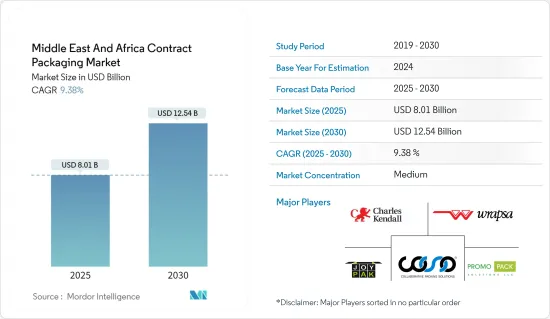
|
시장보고서
상품코드
1640636
중동 및 아프리카의 수탁 포장 : 시장 점유율 분석, 산업 동향 및 통계, 성장 예측(2025-2030년)Middle East And Africa Contract Packaging - Market Share Analysis, Industry Trends & Statistics, Growth Forecasts (2025 - 2030) |
||||||
중동 및 아프리카의 수탁 포장 시장 규모는 2025년에 80억 1,000만 달러로 추정됩니다. 예측 기간(2025-2030년)의 CAGR은 9.38%로, 2030년에는 125억 4,000만 달러에 달할 것으로 예상됩니다.

병 포장 및 충전 서비스는 특히 중동 및 아프리카에서 유망한 성장을 이루고 있습니다. 식품, 식품 및 의약품에 대한수요가 증가함에 따라 많은 기업들이 안전성을 높이기 위해 포장을 아웃소싱하고 있습니다.
중동 및 아프리카는 세계 전자상거래 시장의 주요 기업으로 부상하고 있으며, 성장의 큰 잠재력을 제공합니다. 이 지역의 수많은 나라와 그 2선 도시가 이 동향에 적극적으로 참여하고 있습니다. 이 급성장의 배경에는 기술에 대한 액세스 향상과 인터넷 보급률의 향상이 있어 온라인 쇼핑의 가능성을 높이고 있습니다. mFilterIt이 2023년 12월에 발표한 보고서에 따르면 이 지역의 소매 보급률은 약 11%에서 12%로, 80% 이상의 구매자가 모바일 기기를 이용하고, 70%가 소셜 미디어를 활용해 판매자와 관련이 있습니다. 증가하는 수요에 대응하기 위해 기업은 온라인 쇼핑을 선호하는 소비자를 위해 포장 엔드 투 엔드 또는 단일 서비스를 외주하고 있습니다.
향후 수년간 주사제는 경구제 등 다른 투여 방법을 능가하는 시장 점유율을 획득할 것으로 예상됩니다. 그 결과, 주사제의 수탁 포장 수요가 증가할 것으로 예상되고, 주요 제약 벤더는 지역별 능력을 높일 것으로 예상됩니다.
많은 지역 브랜드들은 식품 안전 및 재무 및 비즈니스 민첩성의 필요성을 포함하여 제조 작업을 구축하는 대신 공동 포장을 선택합니다. 코패커는 신규 설비에 대한 지출을 정당화할 수 없거나 수익성이 낮은 신제품을 생산하기 위한 설비에서 생산을 분리할 수 있는 이 지역의 충분한 식음료 기업에 필수적인 역할을 하고 있습니다.
그러나 자사 포장에 대한 수요 증가는 수탁 포장 시장의 성장을 방해할 것으로 예상됩니다. 예를 들어, 외부 수탁 포장업체를 이용하는 기업은 유통 사이클을 최대 7일까지 연장할 수 있으며, 그 사이에는 제품을 보기 어려워집니다. 제품을 신속하고 효과적으로 유통시키고자 하는 기업의 경우, 이것이 장벽이 될 수 있습니다.
대부분의 소비자가 온라인 쇼핑을 선호하는 동안 기업은 증가하는 수요에 대응하기 때문에 포장을 엔드 투 엔드 또는 단독으로 아웃소싱하고 있습니다.
중동 및 아프리카 수탁 포장 시장 동향
전자상거래 수요 증가가 시장을 크게 견인
- 전자상거래 포장 기업은 현대 기술의 중요한 채용자이자 추진자입니다. 세계 전자상거래 기업 증가는 고객의 요구에 더 잘 대응하기 위한 포장 솔루션에 대한 업계 수요에 박차를 가하고 있습니다.
- 또한 소비자 포장 상품(CPG) 제공업체의 높은 변동성 요구사항으로 공급망의 속도와 함께 커스터마이즈는 전자상거래를 통해 제품을 제공하는 기업에 대한 과제를 만들고, 따라서 유연성, 민첩성, 임기응변을 위해 구축되어 있기 때문에 맞춤형 전자상거래 포장 솔루션을 위한 수탁 포장 회사의 요구사항을
- 수탁 포장업자와 프루필먼트 서비스 제공업체는 한정된 수량으로 소규모로 사업을 전개하고 의사결정에 종사하는 인원도 적습니다. 이를 통해 전자상거래 포장 혁신을 보다 신속하게 구현할 수 있습니다. 또한 전자상거래 기업과 협력하여 급성장하는 이 채널에 최적화된 포장으로의 길을 단축할 수 있습니다.
- 미국 농무부 해외 농업국에 따르면 아랍에미리트(UAE)의 2023년 소매 전자상거래 매출세별 소매액은 전년 56억 달러에서 약 62억 달러에 이릅니다. 소매 매출이 증가하면 일반적으로 포장 상품에 대한 수요가 증가하고 주요 기업은 포장 요구를 포장 계약 회사에 위임하게 됩니다. 이러한 수요의 급증은 포장 계약자의 비즈니스 기회 확대로 이어질 수 있으며, 소매업체 증가하는 요구에 부응하기 때문에 사업 확대 및 신기술 투자를 촉진할 수 있습니다.
현저한 성장을 이루는 음료 업계
- 가공에 필수적인 인프라에 대한 수요가 높아지고 있는 가운데, 음료 제조업체나 주스 제조업체는 보다 핵심적인 활동에 힘을 주기 시작하고 있습니다. 제조업체는 위생적인 가공 기준을 염두에 두면서 적절한 기술적 전문 지식과 적시에 비용 효율적인 솔루션을 제공함으로써 원료를 보관하는 전용 영역을 가진 포장 벤더에 기대를 걸고 있으며, 이 지역에서 음료 포장 수탁 서비스 수요를 높이고 있습니다.
- 많은 새로운 시대의 음료는 유통이 광범위하지만 판매량이 제한되어 있기 때문에 공장 참여가 정당화되기에는 너무 적은 양에도 불구하고 여러 제조 기지가 필요합니다. 핫필 제품에 대한 수요가 높기 때문에 유명 브랜드를 보유한 대기업은 생산 요건을 충족하기 위해 수탁 포장업자를 사용합니다.
- 2024년 2월 남아프리카 통계국의 데이터에 따르면, 남아프리카 소비자 물가 지수(CPI)는 식품 및 비알코올 음료에 대해 113.9점으로 측정되었습니다. 제조업체는 경쟁력 있는 가격을 유지하면서 소비자 수요를 충족하기 위해 효율적이고 비용 효율적인 솔루션을 찾고 있기 때문에 국내에서는 수탁 포장 서비스에 대한 수요가 증가하고 있습니다.
- 수또한 계약 제조업체는 캔, 병, 항아리, 상자 등에 대한 병입 및 충전, 팔레트 진열, 판촉용 포장, 제품 진열, 맞춤형 조립, 수동 포장 등의 번들링 서비스를 제공합니다. 식품, 음식, 제약 업계는 1차 포장을 가장 많이 채용하고 있는 업계 중 하나입니다. 그러므로 이러한 산업의 전체 생산 능력 성장은 지역 전체에서 1차 계약 포장 서비스의 채택을 촉진할 것으로 예상됩니다.
- 수탁 포장 기업의 전문 지식과 인프라를 활용함으로써 제조업체는 효율적이고 연포장 솔루션의 혜택을 누리면서 제품 개발 및 마케팅과 같은 핵심 업무에 집중할 수 있습니다. 이 동향은 동적 비즈니스 환경에서 공급망 운영을 최적화하고 시장 대응력을 강화하는 데 수탁 포장 회사가 제공하는 가치 프로포지션에 대한 인식의 높아짐을 반영합니다.
중동 및 아프리카 수탁 포장 산업 개요
중동 및 아프리카의 계약 포장 시장은 반고체화되고 있습니다. 지역 시장 개척과 해외 직접 투자에 대한 현지 기업의 점유율 확대가 이 세분화를 촉진하는 주요 요인이 되고 있습니다.
- 2023년 9월 - 의약품 제조, 포장 및 사내 실험실을 제공하는 남아프리카의 제3자 의약품 제조 및 포장 회사인 Wrapsa는 추가 현지화에 주력할 계획을 밝혔습니다. 이 회사는 정제, 시럽, 연고, 분말, 발포제, 구미 등 모든 의약품 형식 및 포장을 지원할 수 있습니다.
- 2023년 1월 - StrongPack은 2023년 초에 나이지리아의 고속 PET 물 라인의 일부로 Sidel사의 블로우 성형기를 설치한다고 발표했습니다. StrongPack은 나이지리아의 비 알코올 음료 공동 패커 중 하나입니다. 새로운 매시간 8만 6,000개의 고속 라인은 아프리카에서 가장 빠르며 StrongPack사가 스틸워터의 코패킹 시장에 진입함을 보여줍니다.
기타 혜택 :
- 엑셀 형식 시장 예측(ME) 시트
- 3개월의 애널리스트 서포트
목차
제1장 서론
- 조사의 전제조건과 시장 정의
- 조사 범위
제2장 조사 방법
제3장 주요 요약
제4장 시장 인사이트
- 시장 개요
- 산업 밸류체인 분석
- 산업의 매력도 - Porter's Five Forces 분석
- 공급기업의 협상력
- 소비자의 협상력
- 신규 진입업자의 위협
- 대체품의 위협
- 경쟁 기업 간 경쟁 관계의 강도
제5장 시장 역학
- 시장 성장 촉진요인
- 급속한 기술의 진보
- 소매 체인 개발
- 시장 성장 억제요인
- 원재료와 포장제품의 비용 상승
제6장 시장 세분화
- 서비스 유형별
- 1차 포장
- 2차 포장
- 3차 포장
- 업계별
- 음료
- 식품
- 의약품
- 홈&패브릭 케어
- 뷰티케어
- 국가별
- 아랍에미리트(UAE)
- 사우디아라비아
- 남아프리카
- 이집트
- 나이지리아
제7장 경쟁 구도
- 기업 프로파일
- Joypak(Pty) Ltd.
- StrongPack Ltd.
- Collaborative Packing Solutions
- Charles Kendall Group
- Promo Pack Solutions LLC
- Al Bustan Co-Packing LLC
- Al Sharaf Repacking Services
- Gulf Trading and Refrigerating LLC(GULFCO)
- Wrapsa(Pty) Ltd.
- PackMan Packaging
제8장 투자 분석
제9장 시장 전망
KTH 25.02.19The Middle East And Africa Contract Packaging Market size is estimated at USD 8.01 billion in 2025, and is expected to reach USD 12.54 billion by 2030, at a CAGR of 9.38% during the forecast period (2025-2030).

Bottling and filling services have particularly experienced promising growth in the Middle East and Africa. Owing to the increased demand for food, beverage, and pharmaceutical needs, many businesses have outsourced their packaging for increased safety.
The Middle East and Africa have emerged as key players in the global e-commerce market, offering substantial potential for growth. Numerous countries in the region and their tier-two cities are actively participating in this trend. This surge is driven by increased accessibility to technology and higher internet penetration rates, amplifying online shopping prospects. According to a report published by mFilterIt in December 2023, retail penetration in the region stands at approximately 11% to 12%, with over 80% of buyers utilizing mobile devices and 70% leveraging social media to engage with sellers, creating opportunities for contract packaging services. To keep up with the growing demand, businesses outsource their packaging end-to-end or standalone services to consumers who prefer to shop online.
Over the upcoming years, injectables are anticipated to gain a market share that surpasses that of other administration methods, such as oral. As a result, contract packaging demand for injectable solutions is expected to rise, and significant pharmaceutical vendors are anticipated to increase their regional capabilities.
Many regional brands opt for co-packing instead of building their manufacturing operations, including food safety and the need for financial and business agility. Co-packers play an essential role for ample food and beverage companies in the region that may be unable to justify spending on new equipment or divert production from equipment to produce new and less profitable products.
However, the growing demand for in-house packaging is anticipated to hinder the market growth for contract packaging. For instance, businesses that use outside contract packagers can extend their distribution cycle by up to seven days, during which their product is less visible. Companies looking to distribute their goods quickly and effectively may find this a barrier.
With most consumers prefer online shopping channels, companies have been outsourcing their packaging end-to-end or standalone services to meet the growing demand.
Middle East And Africa Contract Packaging Market Trends
Increasing Demand in E-Commerce will Significantly Drive the Market
- E-commerce packaging companies are significant adopters and drivers of modern technology. The increasing number of global e-commerce companies is also fueling the industry's demand for packaging solutions to better cater to customers' needs.
- Additionally, with high variability requirements from Consumer-packaged goods (CPG) providers, customization along with speed in the supply chain creates a challenge for product offering companies via e-commerce, thus escalating the requirements from contract packaging companies for a customized e-commerce packaging solution, as they are built for flexibility, agility, and resourcefulness.
- Contract packers and fulfillment service providers operate on a smaller scale with limited volumes and fewer people involved in decision-making. As a result, they can implement e-commerce-ready packaging innovations more quickly. Furthermore, collaborating with e-commerce companies can shorten the path to optimized packaging for this rapidly growing channel.
- According to the USDA Foreign Agricultural Service, in 2023, the retail value, excluding sales tax of retail e-commerce in the United Arab Emirates, reached around USD 6.2 billion, up from USD 5.6 billion in the previous year. As retail sales increase, there is typically a higher demand for packaged goods, leading companies to outsource their packaging needs to contract packaging firms. This surge in demand can lead to increased opportunities for contract packaging providers, potentially prompting them to expand their operations or invest in new technologies to meet the growing needs of retailers.
Beverage Industry to Witness Significant Growth
- With the increasing demand for essential infrastructure to process, beverage, and juice manufacturers have started focusing more on core activities. Manufacturers are looking forward to packaging vendors with a dedicated area to store the raw material by providing the right technical expertise and timely and cost-effective solutions while keeping in mind hygienic processing standards, which has given rise to the demand for contract beverage packaging services in the region.
- Many new-age beverages have widespread distribution but limited volume, necessitating multiple manufacturing locations for volumes far too small to justify plant involvement. Due to the high demand for hot-fill products, large corporations with well-known brands have turned to contract packers to meet their production requirements.
- As per Statistics South Africa data in February 2024, the Consumer Price Index (CPI) in South Africa was measured at 113.9 points regarding food and non-alcoholic beverages. There is an uptick in demand for contract packaging services in the country as manufacturers seek efficient and cost-efficient solutions to meet consumer demand while maintaining competitive pricing.
- Contract manufacturers also provide bundling services such as bottling and filling, pallet displays, promotional packaging, product displays, custom assembly, manual packaging, etc., for cans, bottles, jars, cartons, etc. The food, beverage, and pharmaceutical industries are some of the biggest adopters of primary packaging. Therefore, the growth in the overall production capacity of these industries is expected to drive the adoption of primary contract packaging services across the region.
- By leveraging the expertise and infrastructure of contract packaging firms, manufacturers can focus on their core competencies, such as product development and marketing, while benefitting from efficient and flexible packaging solutions. This trend reflects a growing recognition of the value proposition offered by contract packaging companies in optimizing supply chain operations and enhancing market responsiveness in a dynamic business environment.
Middle East And Africa Contract Packaging Industry Overview
The Middle East and Africa contract packaging market is semi-consolidated. The development of regional markets and the increasing shares of local players in foreign direct investments are the major factors promoting this fragmentation.
- September 2023 - Wrapsa, a South African third-party pharmaceutical manufacturing and packaging company offering pharma manufacturing, packing, and an in-house laboratory, revealed its plan to focus on more localization. The company can cater to all medicine formats and packaging, including tablets, syrups, ointments, powders, effervescent, or gummies.
- January 2023 - StrongPack announced the installation of a blow-molder from Sidel as part of a high-speed PET water line in Nigeria in early 2023. StrongPack is one of Nigeria's co-packers of non-alcoholic beverages. The new 86,000 bottles per hour (bph) high-speed line is set to be the fastest in Africa, indicating StrongPack's entry into the still water co-packing market.
Additional Benefits:
- The market estimate (ME) sheet in Excel format
- 3 months of analyst support
TABLE OF CONTENTS
1 INTRODUCTION
- 1.1 Study Assumptions and Market Definition
- 1.2 Scope of the Study
2 RESEARCH METHODOLOGY
3 EXECUTIVE SUMMARY
4 MARKET INSIGHTS
- 4.1 Market Overview
- 4.2 Industrial Value Chain Analysis
- 4.3 Industry Attractiveness - Porter's 5 Force Analysis
- 4.3.1 Bargaining Power of Suppliers
- 4.3.2 Bargaining Power of Consumers
- 4.3.3 Threat of New Entrants
- 4.3.4 Threat of Substitute Products
- 4.3.5 Intensity of Competitive Rivalry
5 MARKET DYNAMICS
- 5.1 Market Drivers
- 5.1.1 Rapid Technology Advancements
- 5.1.2 Development in the Retail Chain
- 5.2 Market Restraints
- 5.2.1 Increasing cost of Raw material and Packaging products
6 MARKET SEGMENTATION
- 6.1 By Service Type
- 6.1.1 Primary Packaging
- 6.1.2 Secondary Packaging
- 6.1.3 Tertiary Packaging
- 6.2 By End-User Vertical
- 6.2.1 Beverages
- 6.2.2 Food
- 6.2.3 Pharmaceuticals
- 6.2.4 Home and Fabric Care
- 6.2.5 Beauty Care
- 6.3 By Country
- 6.3.1 United Arab Emirates
- 6.3.2 Saudi Arabia
- 6.3.3 South Africa
- 6.3.4 Egypt
- 6.3.5 Nigeria
7 COMPETITIVE LANDSCAPE
- 7.1 Company Profiles
- 7.1.1 Joypak (Pty) Ltd.
- 7.1.2 StrongPack Ltd.
- 7.1.3 Collaborative Packing Solutions
- 7.1.4 Charles Kendall Group
- 7.1.5 Promo Pack Solutions LLC
- 7.1.6 Al Bustan Co- Packing LLC
- 7.1.7 Al Sharaf Repacking Services
- 7.1.8 Gulf Trading and Refrigerating LLC (GULFCO)
- 7.1.9 Wrapsa (Pty) Ltd.
- 7.1.10 PackMan Packaging



















